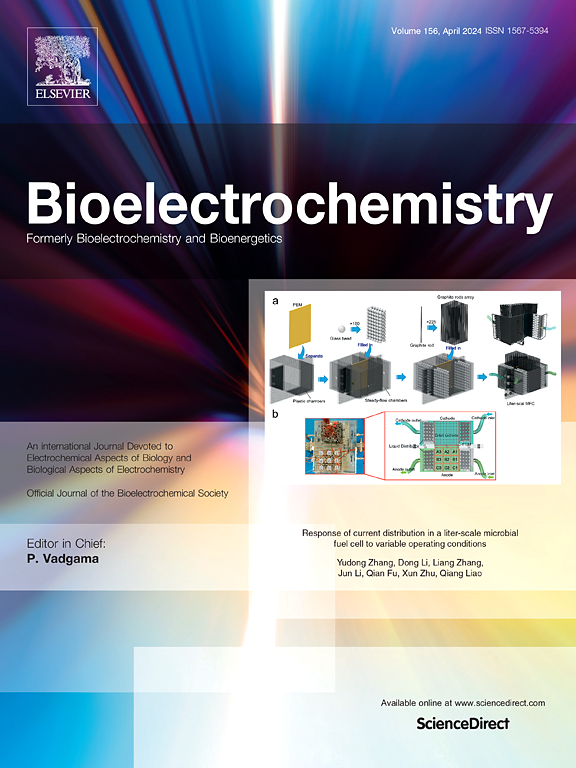N,N ' -双(2-噻基亚甲基)-1,x -二氨基苯电聚合膜修饰玻碳电极对纯香草酸和4-羟基苯乙酸的电化学行为
IF 4.8
2区 化学
Q1 BIOCHEMISTRY & MOLECULAR BIOLOGY
引用次数: 0
摘要
本研究评价了修饰玻碳电极(GCEs)检测乳腺癌相关尿液生物标志物同质香草酸(HVA)和4-羟基苯基乙酸(4HPA)的不同电化学行为。分析是在常见的尿干扰物,肌酐和尿素的存在下进行的。通过电聚合N,N ' -双(2-噻基亚甲基)-1,X-二氨基苯(X = 2,3,4)异构体,即所谓的BTMD,对裸gce进行改性。利用循环伏安法(CV)、电化学阻抗谱(EIS)、原子力显微镜(AFM)和扫描电镜(SEM)研究了这些聚合物层的形成和特性。差分脉冲伏安法(DPV)测量了电极对HVA和4HPA的响应,评估了它们的灵敏度和选择性。结果表明,所开发的电极有效地检测到这两种生物标志物,其峰值电流随生物标志物浓度成比例地增加,并且肌酐和尿素的干扰最小。在较高的浓度下,修饰电极表现出较好的线性;然而,在高浓度的p-BTMD/GCE中观察到4HPA的饱和。每个电极都显示出独特的峰值电流,电位和响应曲线,突出了它们在交叉反应传感系统(如电子舌头)中分析复杂矩阵(如尿液)的前景。本文章由计算机程序翻译,如有差异,请以英文原文为准。
Electrochemical Behavior of Glassy Carbon Electrodes Modified with Electropolymerized Film of N,N′-bis (2-thienylmethylene)-1,X-diaminobenzene toward Homovanillic Acid and 4-Hydroxyphenylacetic Acid
This study evaluates different electrochemical behaviors of modified glassy carbon electrodes (GCEs) for detecting urinary biomarkers related to breast cancer, namely homovanillic acid (HVA) and 4-hydroxyphenylacetic acid (4HPA). The analysis was performed in the presence of common urinary interferents, creatinine and urea. Modification of bare GCEs was done through the electropolymerization of N,N′-bis (2-thienylmethylene)-1,X-diaminobenzene (X = 2, 3, 4) isomers, so-called BTMD. The formation and characteristics of these polymeric layers were investigated using cyclic voltammetry (CV), electrochemical impedance spectroscopy (EIS), atomic force microscopy (AFM), and scanning electron microscopy (SEM). Differential pulse voltammetry (DPV) was used to measure responses of the electrodes to HVA and 4HPA, assessing their sensitivity and selectivity. Results showed that the developed electrodes effectively detected both biomarkers, with peak currents increasing proportionally to biomarker concentrations and minimal interference from creatinine and urea. The modified electrodes exhibited better linearity at higher concentrations; however, saturation was observed for 4HPA at high concentrations with the p-BTMD/GCE. Each electrode displayed unique peak current, potential, and response profiles, highlighting their promise for cross-reactive sensing systems, such as electronic tongues, to analyze complex matrices such as urine.
求助全文
通过发布文献求助,成功后即可免费获取论文全文。
去求助
来源期刊

Bioelectrochemistry
生物-电化学
CiteScore
9.10
自引率
6.00%
发文量
238
审稿时长
38 days
期刊介绍:
An International Journal Devoted to Electrochemical Aspects of Biology and Biological Aspects of Electrochemistry
Bioelectrochemistry is an international journal devoted to electrochemical principles in biology and biological aspects of electrochemistry. It publishes experimental and theoretical papers dealing with the electrochemical aspects of:
• Electrified interfaces (electric double layers, adsorption, electron transfer, protein electrochemistry, basic principles of biosensors, biosensor interfaces and bio-nanosensor design and construction.
• Electric and magnetic field effects (field-dependent processes, field interactions with molecules, intramolecular field effects, sensory systems for electric and magnetic fields, molecular and cellular mechanisms)
• Bioenergetics and signal transduction (energy conversion, photosynthetic and visual membranes)
• Biomembranes and model membranes (thermodynamics and mechanics, membrane transport, electroporation, fusion and insertion)
• Electrochemical applications in medicine and biotechnology (drug delivery and gene transfer to cells and tissues, iontophoresis, skin electroporation, injury and repair).
• Organization and use of arrays in-vitro and in-vivo, including as part of feedback control.
• Electrochemical interrogation of biofilms as generated by microorganisms and tissue reaction associated with medical implants.
 求助内容:
求助内容: 应助结果提醒方式:
应助结果提醒方式:


